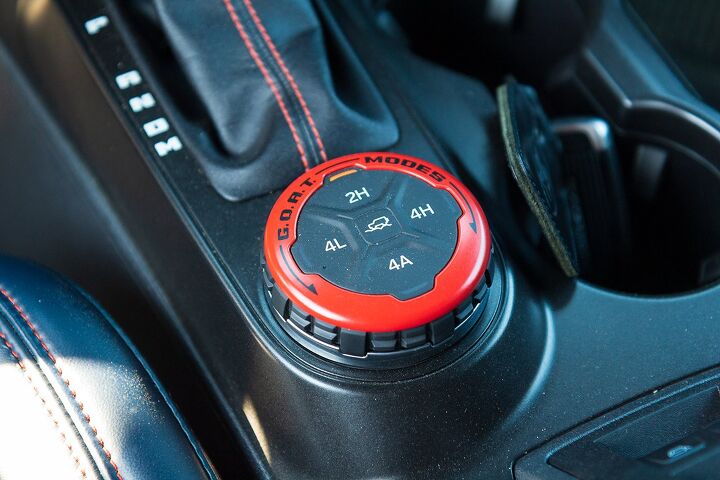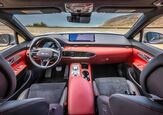2022 Ford Bronco Raptor Review: First Drive
FAST FACTS
| Engine: | 3.0 L Turbo |
| Output: | 418 hp, 440 lb-ft |
| Transmission: | 10AT, 4X4 |
| US fuel economy (MPG): | 15/16 |
| CAN fuel economy (L/100KM): | 15.7/14.8 |
| Starting Price (USD): | $70,095 (inc. dest.) |
| Starting Price (CAD): | $102,190 (inc. dest.) |
Obey your Raptor. The trail goes faster. Faster!
The 2022 Ford Bronco Raptor isn’t meant to do what the F-150 Raptor can do off-road, according to the brand. It’s meant to do more. To handle the same dune-jumping and gravel-running that the pickup can but then crawl over boulders, rocks, and trails that would send the original Raptor running back to the Cretaceous period.
Get a Quote on a New Ford BroncoThere was nothing to benchmark for the Ford Performance team. Nothing on the market, they said, could do what they needed the Bronco Raptor to do. So they built a benchmark vehicle. Taking a Jeep Wrangler Rubicon and adding around $12,000 in aftermarket wheels, tires, and suspension and then finding out what that vehicle was capable of. And then trying to beat it.
2022 Ford Bronco Raptor – Have Suspension, Will Travel
On the spreadsheet that equals axles taken from the Bronco DR race truck. A Dana 50 in the rear and a Dana 44 in the front with stronger half shafts and an extra 8.6-inches of track.
New control arms give the Braptor – and that’s what we’re calling it from now on – 13-inches of suspension travel up front and 14 in the rear (330 mm and 356 mm). That’s 60 and 40 percent more than the standard Bronco.
Numbers that mean nothing until you see the Braptor at full suspension droop. Suddenly the beefy Dana 50 rear axle looks like a toothpick dangling in the breeze. Seeing that much air both above and below the axles is astonishing in any vehicle, let alone one that’s available from your local dealer.
Tilt it the other way and the standard BF Goodrich KO2 all-terrain tires – the same 37s offered on the F-150 Raptor – are suddenly tucked into the fenders like you’ve dropped it on airbags.
Magic Shocks
Riding behind another Bronco Raptor on the trail, what stands out is how effortless it all looks. There is almost no movement of the body of the SUV. The suspension goes up and down over rocks the size of trash cans, and the cabin stays put.
From the inside, it’s not as smooth as it looks, but it’s still a softer ride when driving over felled logs, rocks, and tractor ruts than most trucks manage on poor pavement.
Credit for that goes to the Fox Live Valve adaptive shocks. The dampers have huge 3.1-inch-diameter pistons on equally sturdy shafts. Remote fluid reservoirs help make sure the shock fluid doesn’t overheat (or cavitate) on the roughest trails on the hottest days.
It’s the Live Valve damping that uses height (and a load of other) sensors to adjust each shock hundreds of times per second. They don’t just turn the ride into something uniquely cushy on the trail, the High Performance Off Road Stability 4.0 suspension system can essentially stop the Braptor from smashing into the bump stops or jarring you with full extension. Off of paved roads, it’s practically magic.
Tough Truck Needs to be Tough
We can’t ignore the effect that the electronic sway bar disconnect has on the trail. The same bar that keeps the Bronco stable on the highway and flat in corners hurts wheel articulation on the trail. Unhooking it lets the front wheels move more independently and that makes the ride even softer when things get rough.
Ford added so much capability to the Bronco Raptor that the very core of the vehicle needed upgrades. The frame was strengthened front and rear, with all-new shock towers in the front. The B and C-Pillars were both reinforced, making the body 50 percent stiffer than a standard four-door Bronco.
Boosted Power
The engine is Ford’s sort-of-familiar 3.0L twin-turbo EcoBoost V6. Tuning specific to the Braptor including a free-flowing exhaust ups it to 418 horsepower along with 440 lb-feet of torque. Those are big numbers, but this is a heavy steed that’s also spinning a tire and wheel package that adds up to around 100 pounds (45 kg) at each corner.
That weight puts a damper on the performance. The Braptor is clearly quicker than any other Bronco, but we can’t call it fast. Even with the 10-speed automatic handling gears like a big-city juggler, we can’t help but wish that the 3.5L EcoBoost from the Raptor pickup showed up under the hood.
Why no 3.5? It didn’t fit. Part of the Raptor business case is to use as many parts as possible that already worked with the platform. The T6 chassis could fit the 3.0L engine since it’s related to the 2.7. The 3.5 isn’t, so it’s not here.
Ford fitted a new active-valve exhaust to the engine along with (almost) equal-length exhaust manifolds to tweak the Braptor’s roar. It has Normal, Sport, and Quiet modes, as well as the wide-open Baja mode that is accompanied by an on-screen *scolding* that Baja is for off-road use only. As though anyone is planning to heed the advice.
From outside, the Braptor sounds appropriately angry. The little V6 is aggressive, if a little strained, and you get plenty of whiny and poppy turbo noises. From inside, the exhaust settings don’t seem to make much difference, and none of them are particularly appealing. The turbo noises, though, still sound great.
Needs to Look the Part
The extra hardware (and the Raptor attitude) demand changes to the body, and that goes beyond the comically large fender flares – they even have their own tiny mudflaps! The hood is made from sheet-moulding compound instead of steel, letting Ford make it more “muscular” That’s what they call it at least. The black hood vent is real, and functional, though it’s to let hot air out and not to suck cold air in.
Those fender vents are real too, letting more of the hot air out of the engine bay, and the Bronco Raptor needs every one of them and then some. Our drive day wasn’t particularly hot, but the Raptor was putting out serious amounts of heat. You can find out exactly how much heat with the Raptor Gauges that include cylinder head temperature. Just what you need on your commute.
The whole thing is 9.8-inches wider (249 mm) than the standard Bronco, all of that from the axles and obscenely large tires. Between those tires, if you happen to somehow run out of clearance, there are Raptor-specific rock rails. The running boards you’ll see in the pictures are removable, leaving only the rock rails to do their work. With this much ride height, though, you’re probably going to need the running boards.
Does the width actually require the clearance lights Ford has added? We don’t think it does. But just try denying how much attitude they add to the package.
Rugged or Pampering Interior
A base version of the Bronco Raptor gets marine-grade vinyl seats, washout rubber floors, and a normal steering wheel. You probably don’t want that one
You want the upgraded laser-perforated Black Onyx neo suede seats with Ford Performance graphics. These deep buckets will keep you in place off-road. You’re also going to want the Ford Performance steering wheel. The rim is about the same diameter as the handle of a Louisville slugger and is backed by magnesium shifter paddles.
Paddles that are largely useless if the wheel is cranked more than a quarter turn, but do they ever look (and feel) good.
Sync4 is standard on a 12-inch touchscreen, it has a 360-degree camera, and luxury features like B&O audio and adaptive cruise are available. Blah, blah, blah. The off-road electronics are far more interesting. Like the GOAT (Goes Over All Terrain) modes that include a new Baja Mode with anti-lag, a new tow/haul mode that adds 1,000 pounds to max towing, trail control, trail turn assist, and one-pedal driving.
2022 Ford Bronco Raptor – The Verdict
Ford has unarguably built one hell of an off-roader with this Bronco Raptor. It can crush the trail when you’re rock crawling, and it has amazing high speed stability on fast dirt and gravel roads. It’s even still stable on the highway, if you put the shocks in Sport mode, at least. And if you keep in mind that each tire has nearly two feet of sidewall.
There’s just one problem. The Jeep Wrangler Rubicon 392 exists. And it exists with a 6.4L V8 that makes 470 hp, 470 lb-ft, and bellows with a voice that will bring you to tears.
The Jeep may not be as capable off-road, it certainly doesn’t offer the extreme visual cojones of the Bronco Raptor, and it can’t brag about having 37’s from the factory.
But it can go much more quickly and it sounds better doing it.
Crucially, though, the 2022 Ford Bronco Raptor misses the mark in one key area: pure driving excitement. Talking with our colleagues on the Raptor drive, that was the one sentiment that kept popping up. On paper, it should be a blast to drive; a vehicle that jostles occupants around like an amusement park ride, delivery thrills by the second. In practice though, it does not. It’s such a monumental achievement in engineering, and so good and capable, it has unintentionally diluted the fun for the driver.
FAQs
How Fast is the 2022 Ford Bronco Raptor?
Expect the Bronco Raptor to go from 0 to 60 mph in the mid to low six second range.
How many 2022 Ford Bronco Raptors will be built?
Ford has not announced any specific model run numbers for the vehicle. It could depend purely on demand for the vehicle.
What engine comes in the 2022 Ford Bronco Raptor?
Under the hood is a 3.0-liter turbocharged V6 engine making 418 hp and 440 lb-ft of torque.
Become an AutoGuide insider. Get the latest from the automotive world first by subscribing to our newsletter here.
LOVE IT
- Off Road Ability
- Smooth Ride
- Great Looks
LEAVE IT
- Engine Power and Sound
- Lacks Excitement
- Heavy Fuel Bill
Evan moved from engineering to automotive journalism 10 years ago (it turns out cars are more interesting than fibreglass pipes), but has been following the auto industry for his entire life. Evan is an award-winning automotive writer and photographer and is the current President of the Automobile Journalists Association of Canada. You'll find him behind his keyboard, behind the wheel, or complaining that tiny sports cars are too small for his XXXL frame.
More by Evan Williams














































Comments
Join the conversation